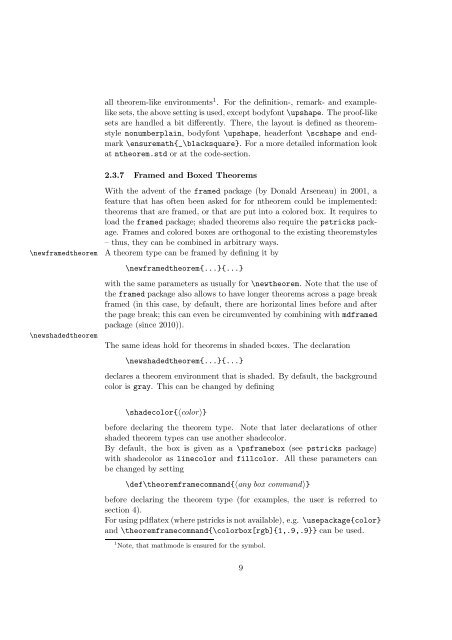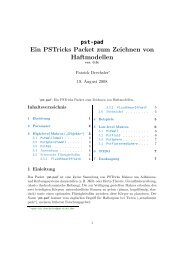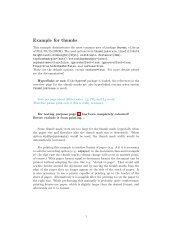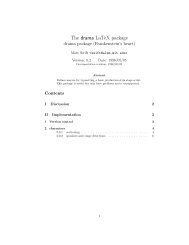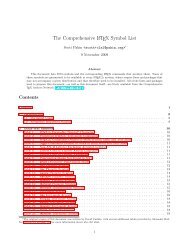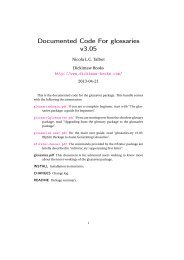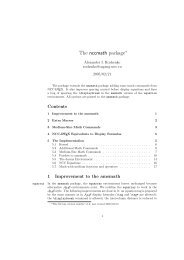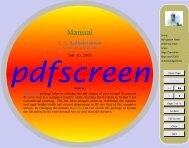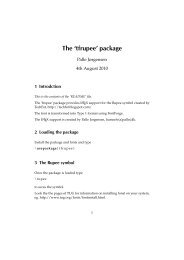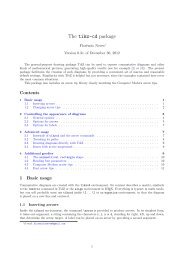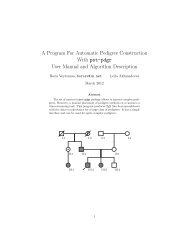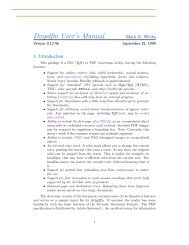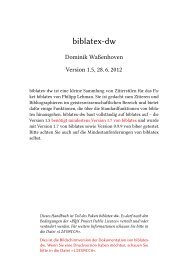ntheorem.pdf. - Mirrors.med.harvard.edu
ntheorem.pdf. - Mirrors.med.harvard.edu
ntheorem.pdf. - Mirrors.med.harvard.edu
Create successful ePaper yourself
Turn your PDF publications into a flip-book with our unique Google optimized e-Paper software.
\newfra<strong>med</strong>theorem<br />
\newshadedtheorem<br />
all theorem-like environments 1 . For the definition-, remark- and examplelikesets,<br />
theabovesettingisused,exceptbodyfont\upshape. Theproof-like<br />
sets are handled a bit differently. There, the layout is defined as theoremstyle<br />
nonumberplain, bodyfont \upshape, headerfont \scshape and endmark<br />
\ensuremath{_\blacksquare}. For a more detailed information look<br />
at <strong>ntheorem</strong>.std or at the code-section.<br />
2.3.7 Fra<strong>med</strong> and Boxed Theorems<br />
With the advent of the fra<strong>med</strong> package (by Donald Arseneau) in 2001, a<br />
feature that has often been asked for for <strong>ntheorem</strong> could be implemented:<br />
theorems that are fra<strong>med</strong>, or that are put into a colored box. It requires to<br />
load the fra<strong>med</strong> package; shaded theorems also require the pstricks package.<br />
Frames and colored boxes are orthogonal to the existing theoremstyles<br />
– thus, they can be combined in arbitrary ways.<br />
A theorem type can be fra<strong>med</strong> by defining it by<br />
\newfra<strong>med</strong>theorem{...}{...}<br />
with the same parameters as usually for \newtheorem. Note that the use of<br />
the fra<strong>med</strong> package also allows to have longer theorems across a page break<br />
fra<strong>med</strong> (in this case, by default, there are horizontal lines before and after<br />
the page break; this can even be circumvented by combining with mdfra<strong>med</strong><br />
package (since 2010)).<br />
The same ideas hold for theorems in shaded boxes. The declaration<br />
\newshadedtheorem{...}{...}<br />
declares a theorem environment that is shaded. By default, the background<br />
color is gray. This can be changed by defining<br />
\shadecolor{〈color〉}<br />
before declaring the theorem type. Note that later declarations of other<br />
shaded theorem types can use another shadecolor.<br />
By default, the box is given as a \psframebox (see pstricks package)<br />
with shadecolor as linecolor and fillcolor. All these parameters can<br />
be changed by setting<br />
\def\theoremframecommand{〈any box command〉}<br />
before declaring the theorem type (for examples, the user is referred to<br />
section 4).<br />
Forusing<strong>pdf</strong>latex(wherepstricksisnotavailable), e.g. \usepackage{color}<br />
and \theoremframecommand{\colorbox[rgb]{1,.9,.9}} can be used.<br />
1 Note, that mathmode is ensured for the symbol.<br />
9


